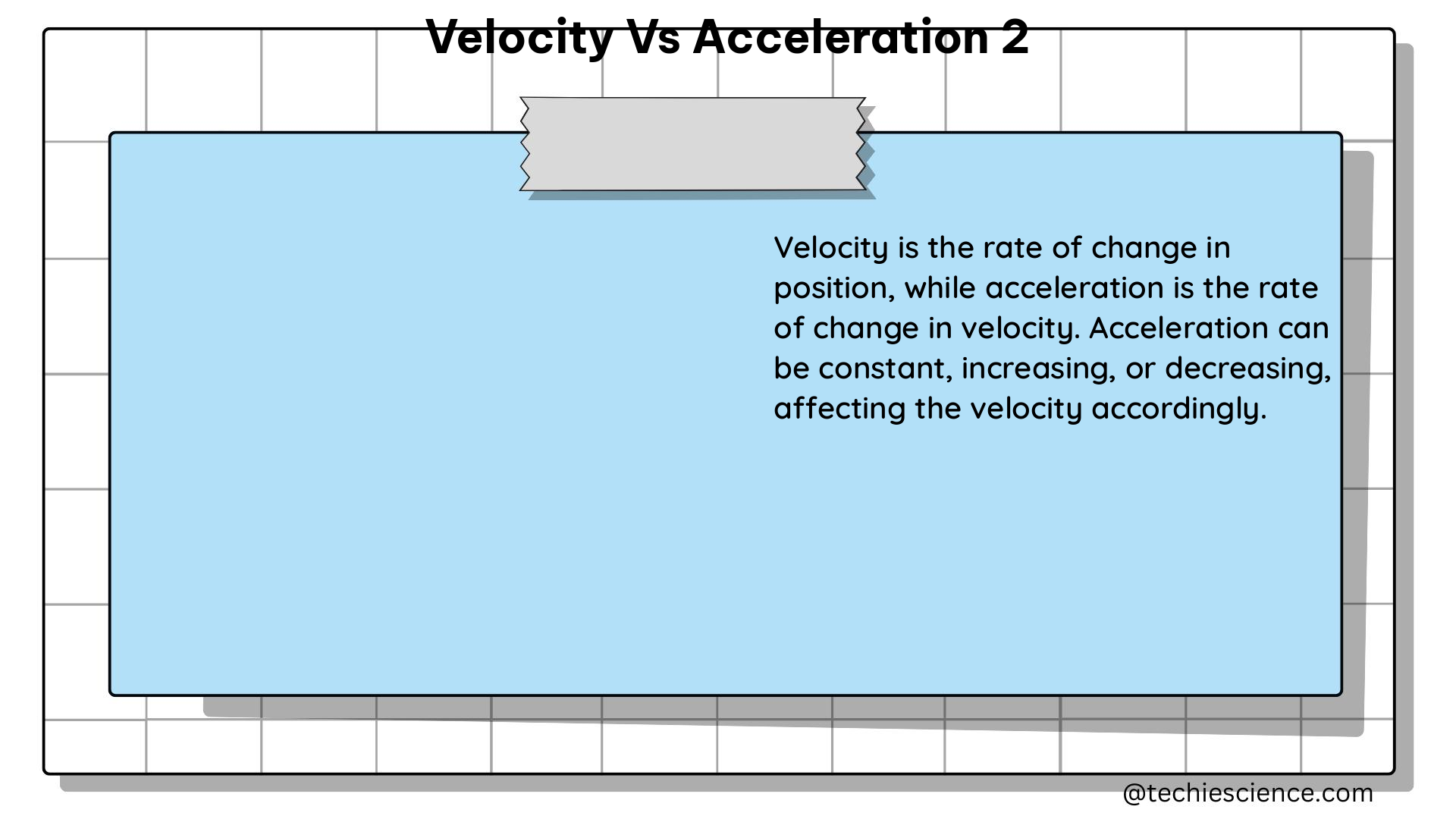Summary
Velocity and acceleration are two fundamental concepts in physics that describe the motion of objects. This comprehensive guide delves into the technical details, formulas, examples, and real-world applications of velocity and acceleration, providing a valuable resource for physics students.
Velocity: Definitions, Units, and Measurement

Definition
Velocity is the rate of change of an object’s position with respect to time. It is a vector quantity, meaning it has both magnitude (speed) and direction.
Unit
The unit of velocity is meters per second (m/s).
Measurement Techniques
- Distance-Time Graphs: By plotting the distance traveled against time, the slope of the graph represents the velocity.
- Speedometers: Many vehicles are equipped with speedometers that display the instantaneous velocity.
- GPS and Radar: GPS and radar technology can track the velocity of objects, including vehicles and projectiles.
Acceleration: Definitions, Units, and Measurement
Definition
Acceleration is the rate of change of an object’s velocity. It is also a vector quantity.
Unit
The unit of acceleration is meters per second squared (m/s²).
Measurement Techniques
- Acceleration-Time Graphs: By plotting the acceleration against time, the slope of the graph represents the change in velocity.
- Accelerometers: These are sensors that measure the acceleration of an object, commonly used in smartphones and other electronic devices.
- Force and Mass: According to Newton’s second law, acceleration can be calculated by dividing the net force acting on an object by its mass (a = F / m).
Relationship Between Velocity and Acceleration
Mathematical Relationship
The acceleration of an object is the derivative of its velocity with respect to time. Mathematically, this is represented as:
$$a = \frac{dv}{dt}$$
where a is the acceleration, v is the velocity, and t is time.
Graphical Representation
Velocity-time graphs and acceleration-time graphs are related. The slope of a velocity-time graph at a given point represents the acceleration at that instant.
Real-World Applications
Understanding the relationship between velocity and acceleration is crucial in various fields, such as:
– Transportation: Acceleration is essential for designing safe and efficient transportation systems, including braking systems in vehicles.
– Robotics: Acceleration is used to control the motion of robots and ensure smooth and precise movements.
– Sports: Athletes often focus on acceleration to improve their performance, such as in sprinting or jumping.
Examples and Numerical Problems
Example 1: Calculating Acceleration
A car accelerates from rest to a velocity of 20 m/s in 4 seconds. What is its acceleration?
$$a = \frac{\Delta v}{\Delta t} = \frac{20\ \text{m/s}}{4\ \text{s}} = 5\ \text{m/s²}$$
Example 2: Calculating Velocity
A ball is thrown upwards with an initial velocity of 15 m/s. If the acceleration due to gravity is 9.8 m/s², what is the velocity of the ball after 2 seconds?
$$v = v_0 + at = 15\ \text{m/s} + (-9.8\ \text{m/s²})(2\ \text{s}) = 15\ \text{m/s} – 19.6\ \text{m/s} = -4.6\ \text{m/s}$$
Theoretical Explanation
Newton’s Laws
The relationship between velocity and acceleration is based on Newton’s laws of motion. The second law states that the acceleration of an object is directly proportional to the net force acting on it and inversely proportional to its mass.
Kinematic Equations
The kinematic equations of motion, such as v = v_0 + at and s = v_0t + \frac{1}{2}at², describe the relationship between velocity, acceleration, and displacement.
Figures and Data Points
Velocity-Time Graph
| Time (s) | Velocity (m/s) |
|---|---|
| 0 | 0 |
| 1 | 5 |
| 2 | 10 |
| 3 | 15 |
| 4 | 20 |
| 5 | 25 |
Acceleration-Time Graph
| Time (s) | Acceleration (m/s²) |
|---|---|
| 0 | 0 |
| 1 | 5 |
| 2 | 10 |
| 3 | 15 |
| 4 | 20 |
| 5 | 25 |
Reference Links
- WebAssign – Qualitative and Quantitative Problems
- HBK – Vibration Measurement: The Complete Guide
- UCSB Physics – Forces and Motion

The lambdageeks.com Core SME Team is a group of experienced subject matter experts from diverse scientific and technical fields including Physics, Chemistry, Technology,Electronics & Electrical Engineering, Automotive, Mechanical Engineering. Our team collaborates to create high-quality, well-researched articles on a wide range of science and technology topics for the lambdageeks.com website.
All Our Senior SME are having more than 7 Years of experience in the respective fields . They are either Working Industry Professionals or assocaited With different Universities. Refer Our Authors Page to get to know About our Core SMEs.